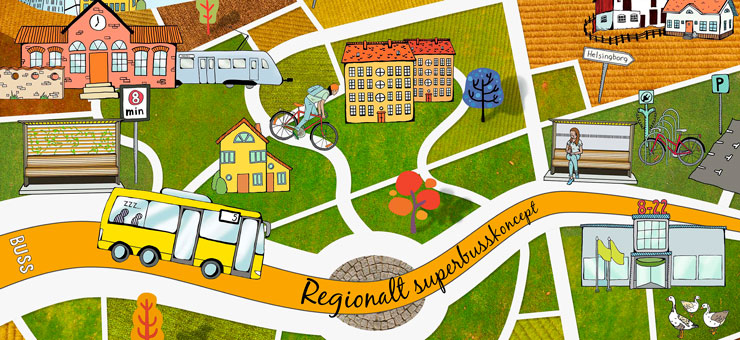Researchers see a bright future for public transport in Skåne
Think of trains – take the bus. This is how the concept will be launched when Skåne switches to superbus routes on the stretches currently covered by the Skåne express. These superbus routes are to compensate for the lack of railways and will be quick and comfortable.
“The goal for 2021 is 8 new efficient lines, which places great demands on collaboration between the Swedish Transport Administration, municipalities, public authorities and the region”, says Fredrik Pettersson, a researcher in transport planning at K2 – the Swedish Knowledge Centre for Public Transport.
Interdisciplinary research forms the basis of K2’s work, which is conducted in close collaboration with all those involved in public transport.
“We follow the processes required for the new superbus routes to become a reality, and we evaluate how public transport can improve in quality and attract more passengers”, explains Fredrik Pettersson.
ON THE SUPERBUSSES OF TOMORROW, passengers will be able to rest comfortably, work or read. It must also be easy and smooth for buses to get through without getting stuck in traffic. Punctuality is an important ingredient. It may be necessary to widen access where space is tight and solving bottlenecks will be a real challenge.
“The bottlenecks often form on the municipal roads, while the funding is only available in the nationwide budget of the Swedish Transport Administration, a public authority”, explains Fredrik Pettersson. “It is a typical problem of practical administration, that the money for measures is available in the wrong budget. As a researcher, I find it very interesting to follow how the stakeholders involved navigate this administrative minefield.”
The superbus routes are intended to be more like commuter trains with few stops on the way. And no stops in minor villages, all to save time.
“There won’t be any bus stops, but stations just like on a railway line. This means, in practice, removing bus stops and that is controversial. Some people will be worse off but others will benefit.”
AT THE SAME TIME, the countryside could liven up if the superbus routes are introduced. People could stay in their homes in the country, work in a bigger city and travel quickly and comfortably on public transport.
“Politically, this is a hard nut to crack and one must dare to prioritise public transport”, believes Fredrik Pettersson. The majority of all travel within Skåne is done by car, and often with only one person per vehicle. How do we attract motorists? The superbuses need not only to be fast and comfortable but also to follow the development of cars, in becoming as environmentally friendly as possible.
The Lund researchers are interested in what measures lead to more travel and improve public transport, and what contributes to making travel pleasant for the passenger.
In two national workshops, doctoral student Joel Hansson at K2, together with 30–40 stakeholders such as municipalities, public transport operators, regional public transport authorities and the vehicle industry, drew up two guidelines to show the way in getting the superbuses rolling. A yellow level guideline outlines a minimum standard while a green level guideline shows how to achieve a really high standard.
Trials are underway around the country to improve bus traffic, although the initiatives usually concern only a single route, or an area with high traffic density or better buses. So it is not only Skåne’s public transport system that is considering replacing trains with buses. In low-density parts of Sweden, the municipalities want to keep the countryside alive and extending the railways is too expensive.
“I believe there are many places in Sweden where superbus routes would be feasible and a good alternative to cars”, maintains Fredrik Pettersson. “But investing in superbuses is a whole concept which has to involve several parts. This is about advanced societal planning in which, politically, one must sometimes dare to be difficult, even if it can lead to conflicts”, says Fredrik Pettersson.
FREDRIK PETTERSSON FINDS IT PROBLEMATIC that the conflict between growth and environmental issues in the transport sector is usually dealt with by proposing to extend the railway network.
“We will never have sufficient funding to build railways everywhere, so why not invest in and use the infrastructure which is already in place more efficiently?”
How do you see public transport in 20 years?
“I am optimistic. Even though there are still mental and administrative obstacles between the stakeholders in public transport in Skåne today, there is also an incredible will to create a public transport system which would function as a backbone to regional development.”
Text: Bodil Malmström
Facts
-
K2 is Sweden’s national centre for research and education in the field of public transport.
-
K2 is run and funded by Lund University, Malmö University and VTI in cooperation with Stockholm County Council, the Region of Västra Götaland and Region Skåne. www.k2centrum.se
-
Urban Arena


